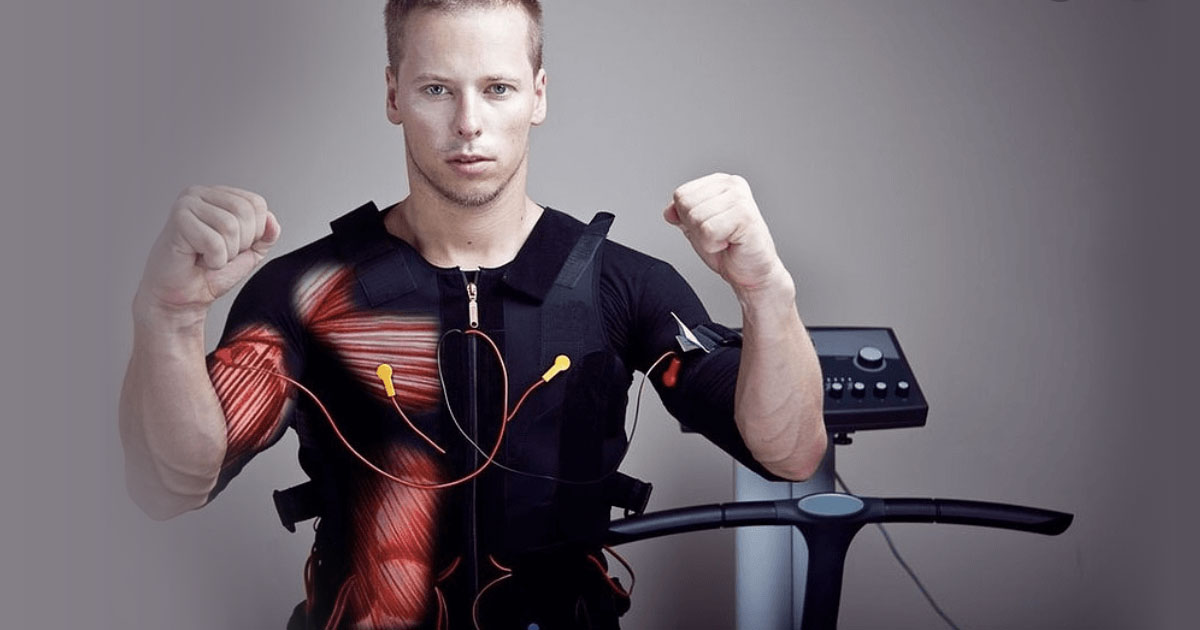Does electrical muscle stimulation really work? A brief introduction into whole-body EMS

EMS (Electrical Muscle Stimulation) is a clinically proven, non-invasive and non-pharmacological method of muscle electrostimulation. EMS training is a type of workout technique.
How do electrical muscle stimulators work?
The whole-body electrical impulses allow the triggering of action potentials on motoneurons of motor nerves (excitations) on the larger muscle’s groups simultaneously. These excitations of motoneurons are transmitted to the muscle fibres via the motor endplate where they generate mechanical muscle fibre responses that correspond to muscle work.
Depending on the parameters of the electrical impulses (pulse frequency, duration of contraction, duration of rest, total session duration), different types of muscle work and physiological reaction can be imposed on the stimulated area.
The various types of muscle work that EMS equipment can impose on the stimulated muscles are able to improve or facilitate muscle performance.
Brief modern history background of electrostimulation

EMS in elite sports - 1976 Montreal Olympics
Dr. Yakov Kots became famous for using electrostimulation in the training programme of Russian athletes. His resulting studies were made public at the 1976 Montreal Olympics claiming 40% force gains.
The electrical current used for stimulating athletes was called Russian Current, or Kots current, and was soon also used by the athletes of other countries thus becoming a widespread sports training method.
Electrostimulation in cosmetics
Faradic treatment (NMES) has also been described in the beauty industry since the 1970 and earlier. The treatment tones the muscles by repeatedly contracting them with the electric current, resulting in their firming and toning, and an increase in muscular metabolism aims to remove waste products more readily.
The great thing about this treatment is that the client lies on the couch and the muscles are exercised for them.
Muscle mass, the key to quality lifestyle
Skeletal muscle is recognized as vital to physical movement, posture, and breathing. It is a highly malleable tissue that is a central factor in whole-body health and the maintenance of energy homeostasis. Skeletal muscle accounts for approximately 45-50% of body mass and plays a fundamental role in locomotion, oxygen (O2) consumption, energy metabolism and substrate turnover and storage.
Benefits of EMS training

Since the appearance of EMS technology, it has been scientifically proven that EMS training achieves better results than conventional exercise and can help improve your strength, body shape and stamina in a number of ways.
Muscle strength and power
Electrical muscle stimulation has proven to be effective in training athletes for better performance in muscle strength and endurance, treating dystrophy disorders.
Cellulite treatment and body toning
Electrostimulation has proven to be effective since targeted muscle groups can exercise. The therapy enhances metabolism by improving blood circulation.
General health
EMS treatment can help in the prevention of detrimental changes due to reduction of muscle mass (approx. 1% per year) leads to sarcopenia and the increase of body fat.
Major contraindications of EMS training
Being a very intensive form of exercise, EMS training must be dealt with caution in case of medical constraints.
- Cardiac pacemaker, implanted defibrillator, or other implanted metallic or electronic device.
- Severe cardiovascular or coronary disease.
- During pregnancy or suspected pregnancy. Whole body EMS has not been tested on pregnant women.
- Uncontrolled epilepsy, or seizure attacks.
- Cancerous lesions and inflamed areas or on infected, wounded or any non-healthy skin area.
- Fever and/or contagious disease.
- Electrodes should not be placed on opposite sides of your head.
- Consultation with a physician prior to using the device is advised after a recent surgical procedure, because stimulation may disrupt the healing process.
- Cautiousness is required when stimulation is applied to menstruating client’s lower abdominal areas.
Fast results with EMS training

As we saw, EMS training is based on low frequency electric muscle stimulation with external electronic impulse complementing the willingly induced muscle contractions. Its effectiveness has scientifically been proven on so many occasions.
And two more things: EMS training is fun and fast. With the necessary training of 20 minutes 2-3 times a week it fits perfectly even into a super busy schedule. After 2-4 weeks generally, you will see visible change in your body — two very enthusiastic thumbs up from us.
Today's EMS devices offer wide flexibility in all settings to suit the needs of each user. In addition, they are often the size of smartphones, which makes them easy to carry or store. Due to the developing technology EMS training equipment often referred to as EMS suits can be successfully used for home training.




